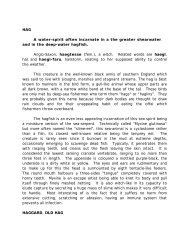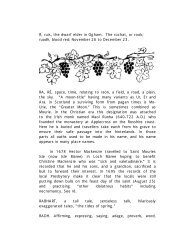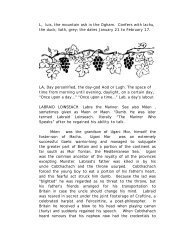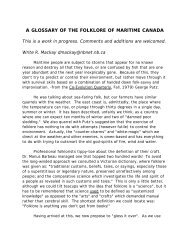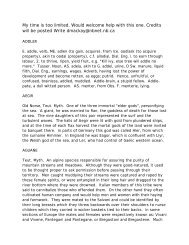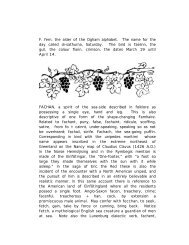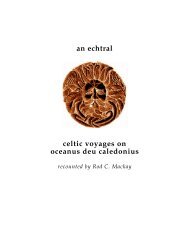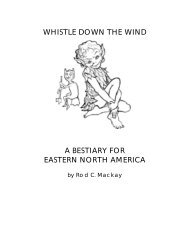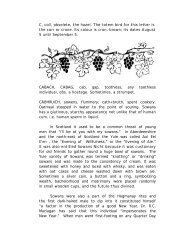G, GORT, ivy in the Ogham alphabet. The bird ... - Rodney Mackay
G, GORT, ivy in the Ogham alphabet. The bird ... - Rodney Mackay
G, GORT, ivy in the Ogham alphabet. The bird ... - Rodney Mackay
You also want an ePaper? Increase the reach of your titles
YUMPU automatically turns print PDFs into web optimized ePapers that Google loves.
Isabel Gowdie said, quite pla<strong>in</strong>ly, "I had a little horse, and<br />
would say, :Horse and Hattock, <strong>in</strong> <strong>the</strong> Divellis name!" And<br />
<strong>the</strong>n he would fly away, where he would even as straws fly<br />
upon <strong>the</strong> high-way." Witches lacked w<strong>in</strong>gs, and so did<br />
honest fairies until co-opted by <strong>the</strong> tale- writers.<br />
J.F. Campbell, research<strong>in</strong>g Popular Tales of <strong>the</strong> West<br />
Highlands, lived for a time with <strong>the</strong> Lapps. He thought that<br />
<strong>the</strong>ir manners and customs were similar to those ascribed<br />
to elves. He located a nor<strong>the</strong>rn dwell<strong>in</strong>g, "round, about<br />
twelve feet <strong>in</strong> diameter, and sunk three feet <strong>in</strong> <strong>the</strong> ground,<br />
<strong>the</strong> roof made of sticks and covered with turf", which he<br />
thought answered <strong>the</strong> description of a fairy, elf, or sidh hill.<br />
He noted that this "hollow-hill" looked like a conical green<br />
mound. At home <strong>in</strong> Scotland he found a very similar<br />
abandoned dwell<strong>in</strong>g <strong>in</strong> <strong>the</strong> sand dunes at South Uist. This<br />
made him suspect that <strong>the</strong> fay-people must have had human<br />
counterparts. He was particularly struck by <strong>the</strong> fact that<br />
<strong>the</strong> average Lapp, "even wear<strong>in</strong>g a high peaked hat", fit<br />
neatly beneath his armpit. Most significantly he said that<br />
<strong>the</strong>y moved from place to place us<strong>in</strong>g long birch vault<strong>in</strong>g<br />
poles.<br />
<strong>The</strong> tradition that witches flew probably has<br />
someth<strong>in</strong>g like this at its base. It is noteworthy that<br />
witches usually departed <strong>the</strong>ir hovels through <strong>the</strong> chimney,<br />
like <strong>the</strong> w<strong>in</strong>d-god Od<strong>in</strong> and Fa<strong>the</strong>r Christmas, who can be<br />
traced to him. Exit<strong>in</strong>g through a modern chimney would be a<br />
considerable feat, but house construction has changed s<strong>in</strong>ce<br />
<strong>the</strong> days of weems, or sod huts. <strong>The</strong> souterra<strong>in</strong>s of <strong>the</strong><br />
Gaels <strong>in</strong> Ireland and Scotland were beehive shaped chambers<br />
made of rock covered with earth. Many of <strong>the</strong>m <strong>in</strong>corporated<br />
long underground entryways protected by traps or<br />
obstructions. Almost all had secondary exits for an<br />
emergency, but <strong>the</strong>re must have been cases where residents<br />
"magically" vanished up <strong>the</strong> hearth-chimney. Surpris<strong>in</strong>gly,<br />
local "Scots" still claim that if you enter by one door and<br />
leave by ano<strong>the</strong>r<br />
strangers will come to visit and bad luck will follow.



